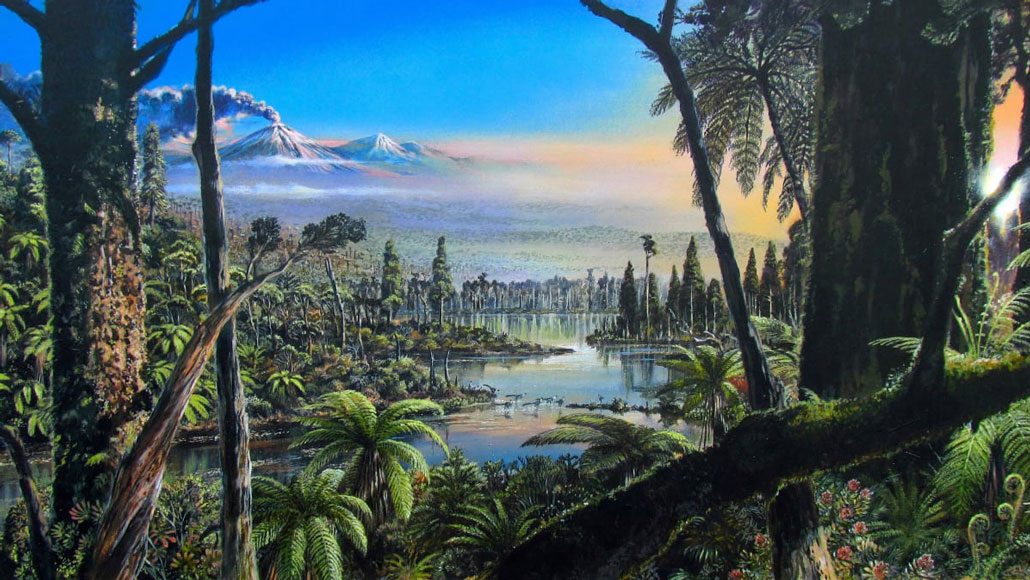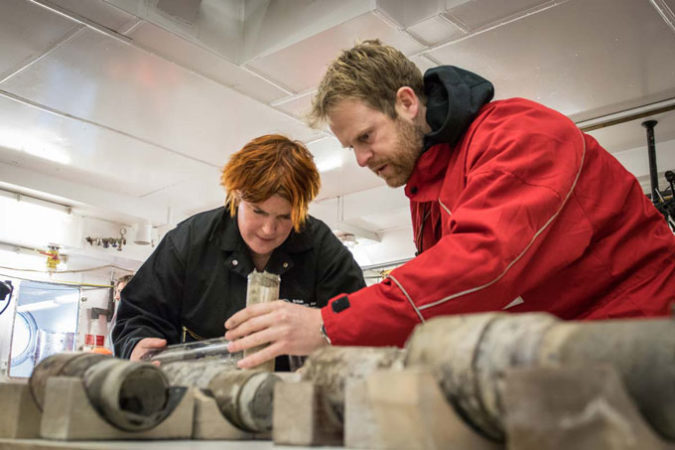A rainforest once grew near the South Pole
A green Antarctica would have been ice-free and the air rich in carbon dioxide

Millions of years ago, a rainforest flourished relatively close to the South Pole. This artist’s image shows what it might have looked like.
J. McKay/Alfred Wegener Institute (CC-BY 4.0)
Share this:
- Share via email (Opens in new window) Email
- Click to share on Facebook (Opens in new window) Facebook
- Click to share on X (Opens in new window) X
- Click to share on Pinterest (Opens in new window) Pinterest
- Click to share on Reddit (Opens in new window) Reddit
- Share to Google Classroom (Opens in new window) Google Classroom
- Click to print (Opens in new window) Print
Once upon a time, a rainforest grew near the bottom of the world.
To find remnants of it, researchers explored the seafloor near Antarctica. In buried sediment there, they found ancient pollen. They also turned up fossilized roots and chemical evidence of a diverse forest. These woods flourished less than a thousand kilometers from the South Pole. That’s only a little more than 600 miles. It’s roughly the distance from New York City to Knoxville, Tenn.
The sediment offers a glimpse of what Earth was like in the distant past. It shows just how warm the planet was during the mid-Cretaceous Period. That was between 92 million and 83 million years ago. From buried traces of vegetation, the scientists reconstructed what the climate must have been like back then.
Average annual temperatures in the forest would have been about 13° Celsius, or 55° Fahrenheit. Summertime temperatures could have reached 25 °C (77 °F). That’s quite warm compared to how frigid Antarctica is now.
The team described its findings April 2 in Nature.
The temperatures aren’t that big a surprise. The mid-Cretaceous was one of the warmest on Earth in the past 140 million years. That estimate is based on studying fossils and seafloor sediments collected closer to the equator. Carbon-dioxide levels in air back then were high. They were at least 1,000 parts per million. (Today’s levels are lower average around 407 ppm. That’s the highest they’ve been at any time in the past 800,000 years.)
But ancient Antarctica wasn’t just warm. It was a forested. And for trees to thrive so far south, something else had to be going on. There had to be even more potent greenhouse-gas conditions. The air would have held more gases, such as carbon dioxide — far more than previously thought. Carbon-dioxide levels could have been between 1,120 and 1,680 ppm, says Johann Klages. He is a marine geologist who works at the Alfred Wegener Institute in Bremerhaven, Germany.
Just like now, he explains, the South Pole millions of years ago got little light — almost none for four months a year. Even so, Antarctica back then “could still have a temperate climate,” Klages says. “It shows us the extreme potency of carbon dioxide — what carbon dioxide can really do.” The gas made it possible for a forest to grow.

Looking back in time
Klages was part of the team that figured out Antarctica had a forest. The group retrieved a core of soil-like material. It was 30 meters (98 feet) long. The researchers took the core from within the Amundsen Sea. That’s near where water melting off of Thwaites and Pine Island glaciers drain into the sea. The researchers knew the core was special before they even studied it closely, Klages says. It was what they saw in the bottom three meters of sediment. It comes from a time in the mid-Cretaceous. And it showed traces of roots.
“We’ve seen many cores from Antarctica,” Klages says, “but we’ve never seen anything like that.”
The core had pollen, too. All this suggested that Antarctica was once a forest full of conifers, ferns and flowering shrubs. There were also mats of bacteria. But the sediment showed no traces of salt. That means it would have been a freshwater swamp.
The forest data also suggest something else. They offer a clue that Antarctica was largely ice-free during the mid-Cretaceous, Klages says. High carbon dioxide in the atmosphere alone wouldn’t have been enough to keep the region balmy so close to the pole. And if it would have had an ice sheet, all that whiteness would have reflected much of the incoming sunlight back into space. That would keep the land cold.
Plant cover would have had the opposite effect. It absorbs and holds the sun’s heat. And that would have boosted greenhouse warming. With more plants and no ice, the atmosphere would have been warmer. That would have allowed trees to flourish.
Julia Wellner is a geologist at the University of Houston, in Texas, who was not involved in the study. The findings offer “an unambiguous record of not just warmer conditions,” she says. They also point to “a diverse forest flora” at the South Pole, she says.
“This paper is a great reminder that, just because there [is] a continent sitting at the South Pole, [that] doesn’t mean it necessarily has to have ice everywhere,” she says. It doesn’t even need to have been particularly cold, she adds.
Past climate, present climate
What lessons might those ancient data tell about modern climate change, such as rising levels of atmospheric carbon dioxide and melting glaciers? That’s hard to know.
It is difficult to make direct parallels between then and now, Wellner points out. Carbon dioxide levels in today’s air are well below mid-Cretaceous levels. Still, they are climbing. And continental landmasses have moved over millions of years. They’ve been pushed and pulled along with the tectonic plates beneath them. Those plates are pieces of Earth’s crust that move. Their movements led, in part, to changes in the flow of ocean waters and air.
The study does highlight several features that are important to overall climate. Ice cover is one of them. Whether there’s a lot of ice or a little matters, Wellner says. What role such features might play in the future is not yet clear. Antarctica’s existing ice sheets, for example, could theoretically limit runaway greenhouse warming. And that could happen even as carbon dioxide levels in the atmosphere continue to rise.
Klages agrees. “Ice present on the planet is a big gift,” he says. “And [we] should do everything we can to keep it.”






